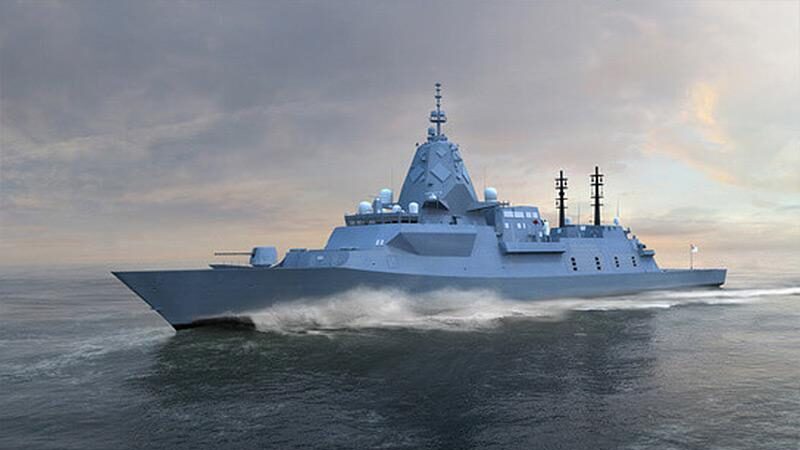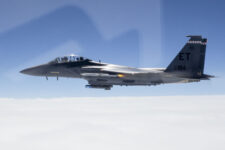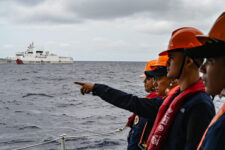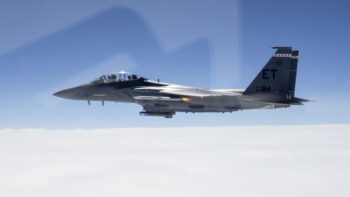
Concept art of the forthcoming Hunter-class frigate. (Australian National Audit Office)
SINGAPORE — Facing years with an aging and shrinking surface fleet, the Labor government of Anthony Albanese today announced its intention to spend $11.1 billion AUD ($7.2 billion US) over the next decade to “double” the size of its fleet and increase its lethality.
However, the decade-long timeline and early skepticism from the political opposition means the plan may never come quite to fruition.
“The Albanese Government is delivering world class, sovereign capabilities through this investment in Navy’s future fleet and Australia’s vital shipbuilding and defence industry,” Defense Minister Richard Marles said in a statement. “After inheriting the oldest surface fleet Navy has operated in its history, this blueprint will see Navy equipped with a major surface combatant fleet over twice as large as planned when we came to government, with more surface combatants in the water sooner.”
Under the new plan, which the government statement claims “will constitute the largest number of surface combatants since WWII,” Australia will have 26 major surface warships.
- Three Hobart class air warfare destroyers with upgraded air defense and strike capabilities;
- Six Hunter class frigates (down from a planned nine) with undersea warfare and strike capabilities
- 11 new general purpose frigates that will provide maritime and land strike, air defense and escort capabilities
- Six new Large Optionally Crewed Surface Vessels (LOSVs) that will significantly increase Navy’s long-range strike capacity
Australia will also field 25 “minor war vessels” for homeland security operations, including six Offshore Patrol Vessels (OPVs). The OPVs had originally been planned to be used as part of the RAN.
The government partly built its plan from an independent surface fleet review it received in October last year. The review, recommended in the Defense Strategic Review, was never made public. The independent analysis was performed by retired Vice Adm. William Hilarides of the US Navy, Rosemary Huxtable, who ran the Australian Finance Department, and retired Vice Adm. Stuart Mayer, Royal Australian Navy, who retired as deputy commander of United Nations Command Headquarters in South Korea.
The government says it will come up with $1.7 billion in new money in what United States budgeteers would call the out-years, three years from now. (Australia budgets in three-year increments.) The rest is called “Forward Estimates,” money that is not yet committed. In total, the Albanese government — which may well not be in office by then — commits to spend $11.1 billion in new funding over the next decade for the surface fleet and “to expand Australia’s shipbuilding industry.”
That money, if passed, would combine with planned acquisition and sustainment investments to result in a total of $54.2 billion in surface fleet spending over the next decade, the government statement says.
The shadow defense minister, Andrew Hastie, was skeptical of the government’s commitment, seeing “serious flaws” in the plan.
“After more than 300 days of waiting, the Opposition welcomes the Government’s response to the long-awaited Surface Fleet Review, the ambition to grow the Royal Australian Navy and the investment into Western Australia’s industrial base. There are, however, serious flaws in Labor’s superficial plan, which the Opposition is yet to be briefed on, despite formal requests,” Hastie said in a statement. “The Albanese Government talks up larger ships, and a larger fleet, but there is no larger strategy and the money in the forward estimates doesn’t cover the cuts that Labor has already made to Defence.”
Hastie said publicly what has been rumored in defense circles for more than six months, that Marles lacks punch in the most important venue in Australia’s budget wars. “The truth is that Richard Marles,” he said, “has once again lost at the Expenditure Review Committee table to (Treasurer) Jim Chalmers, (Foreign Minister) Penny Wong and (Minister for Finance) Katy Gallagher. Under Labor’s plan, we won’t see a ship in the water until 2031. We’ll see HMAS Anzac permanently retired, with no replacement until next decade.”






















